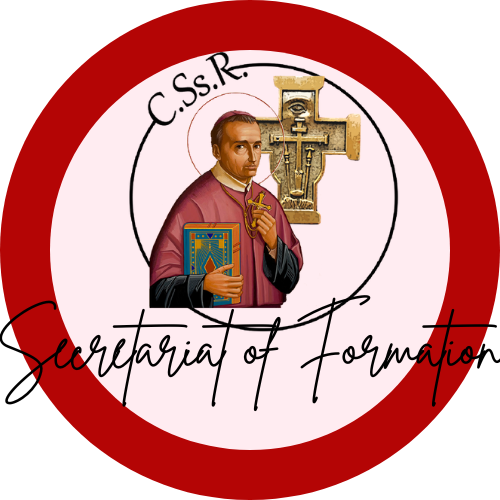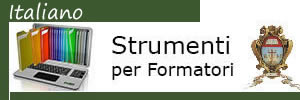Stage: “IMMEDIATE and PREPARATION FOR PERPETUAL PROFESSION
STAGE: “IMMEDIATE PREPARATION FOR PERPETUAL PROFESSION and
THE OATH OF PERSEVERANCE”
ELEMENTS AND REFLECTIVE AIDS FOR THE ELABORATION
OF THE PROGRAM FOR THE REDEMPTORIST FORMATION AT THIS STAGE
INTRODUCTION:
Volume 1 on the series of Redemptorist Formation (Manuale Formatorum, 2009) does not explicitly include a treatment (program, considerations) of this stage of Redemptorist Formation. This document initially is meant to be an aid for the formators of this stage as they design the schedule, the contents and the methodology of the program. This document is not meant to be exhaustive as far as the elements and programming of this program are concerned and it is hoped that every experience of the program is evaluated so that the effectiveness and objectives are progressively improved and more completely realized.
INSTITUTIONAL TEXTS: The following Congregation and Canonical Texts should be taken into account:
CANON LAW:
658. 2° that there has been previous temporary profession for at least three years, without prejudice to the provision of can. 657 §3.
657. §3 Perpetual profession can for a just reason be anticipated, but not by more than three months.
According to the Directory of Superiors an 8 day retreat is to precede the final profession of vows.
C. 668.
§4. A person who must renounce fully his or her goods due to the nature of the institute is to make that renunciation before perpetual profession in a form valid, as far as possible, even in civil law; it is to take effect from the day of profession. A perpetually professed religious who wishes to renounce his or her goods either partially or totally according to the norm of proper law and with the permission of the supreme moderator is to do the same.
§5. A professed religious who has renounced his or her goods fully due to the nature of the institute loses the capacity of acquiring and possessing and therefore invalidly places acts contrary to the vow of poverty. Moreover, whatever accrues to the professed after renunciation belongs to the institute according to the norm of proper law.
CONGREGATION CONSTITUTIONS AND STATUES:
“Religious profession is the definitive act of the whole missionary life of Redemptorists” (Constitution 54).
“Some form of preparation, after the manner of novitiate, is to be made for perpetual profession; it should last for at least a month” (General Statute 075).
“In making perpetual profession, the members will add to the vows mentioned above a vow and oath of perseverance, by which they will bind themselves to live until death in the Congregation.” (Constitution 76)
WILL: “The members are bound to make a will which is valid in civil law. The obligation of making this, however, may be deferred to the time immediately preceding perpetual vows” (Constitution nº 69).
RATIO FORMATIONIS, actualized version, 2019: PREPARATION FOR PERPETUAL PROFESSION
# 70: The immediate program of preparation for Perpetual Profession, which is to last at least one month “after the manner of a second novitiate,” is to be worked out in specific detail in the ratios of the individual Units. This program must include an opportunity for the temporarily professed to deepen their Redemptorist spirituality, to carefully consider their lived experience of the vows, and to deepen the understanding of their commitment to be sealed by the vow and oath of perseverance (cf. C. 76, S. 075). It is recommended that such programs be done on a Conference level.
# 71: Special attention should be given to brothers at the time of their perpetual profession. In a special way this marks the celebration of their vocation in the Congregation and it should be acknowledged as such in a special ceremony.
# 125. AT THE END THE TIME BETWWEN TEMPORARAY AND FINAL PROFESSION:
This is the ordinary moment for the formand to ask for Perpetual Profession, as a definitive option motivated by a solid knowledge of himself and at the same time founded on the grace of God. The formand and the formators must be clear as to the requirements for Perpetual Profession:
- A demonstrated ability to live according to the evangelical counsels and the vows,
- A strong desire to live and work in the Congregation for life,
- An ability to integrate himself into the priorities of the Unit and to do his pastoral work through the community,
- Moral certitude and identification with one´s vocation as Brother, Religious, permanent deacon, or priest.
PREPARATION FOR PERPETUAL PROFESSION
135. The preparation for the perpetual profession will last for at least one month (GS. 075), besides the canonical requirement of an eight-day retreat. “The Program will be for those confreres who have discerned their commitment to the Congregation, applied for the perpetual profession and have been accepted. In so far as possible, preparation for perpetual profession must take place at a Conference level”. (Decree on Initial Formation, General Government, 2015, effective 2016)
136. It is important to remember that the immediate time of preparation just prior to perpetual profession is a formational moment and not simply a “run up” to the liturgical ceremony of the temporarily professed already approved for Perpetual Profession. It is a time of discernment and of verification that precedes the definitive option of the candidate, his written petition, and the official admission granted by the (Vice) Provincial government.
FUNDAMENTAL ELEMENTS OF THE PROGRAM
Both the actualized Ratio Formationis Generalis and the Decree on Formation from the General Government in 2015 expressly recommend that this program must take place, in so far as possible, at the (sub) Conference level, effective 2016.
SOME IMPLICATIONS AND OBSERVATIONS MADE BY THE GENERAL GOVERNMENT:
- Beside at the Conference level, the program may also take place at an inter-conference level.
- It has become common practice in many Units to include the retreat as part of the one-month preparation. This decision allows for adequate preparation and a proper respect for the importance of the canonically mandated retreat.
- Because of the seriousness of the commitment which the confreres are preparing to make, the impression must not be given that this is the “last bridge to cross” before Perpetual Profession.
- This is indeed an important stage of the initial formation process and must be approached with the same seriousness of every other stage and given the necessary time allotted so that the goals of the stage may be achieved.
- Preparation for Perpetual Profession, besides the Novitiate, is one of the most appropriate stages to engage in formation on an Interprovincial/Conference level.
- The Secretariats of formation of the Conferences and the Units, in consultation with the mayor superiors, will have the occasion to work on a program of formation, choose the directors, find an appropriate location, and determine its duration in keeping, of course, with the General Government’s decision.
- As with the other programs, the consideration of a common language has to be taken into account.
OTHER OBSERVATIONS AND SUGGESTIONS FOR THIS STAGE:
RECOMMENDED CONTENT OF A FOUR WEEK PROGRAM:
WEEK ONE: PSYCHIC, EMOTIONAL, RELATIONAL GROWTH
“Whoever follows Christ, the perfect human being, becomes more human.” (Const. 19)
- Psycho-social development, (Vocation history, family map and pattern of communication)
- Psycho emotional self, the body self, (getting in touch with your body)
- Motives (personality, experience of free choice, value clarification, basic needs),
- Transcendent self
- Profession as specification of ‘Baptismal Consecration’ (Const. 47)
Workshop:
- Psychological Assessments,
- Vocation journey,
- Sharing about my experience during the First Formation.
WEEK TWO: CONGREGATION OF THE MOST HOLY REDEEMER
- Belonging to a religious congregation “Carrying out its mission in the Church the Congregation unites members who live together and form one missionary body” (Const. 2).
- Institutional vs. personal: gifts and challenges.
- History of the Congregation and spread of the congregation.
- Conference, Profile, networking, interprovincial experiences, etc.
- General Chapter, Communicanda, etc.
- Constitutions, process
Workshop:
- Presentation of my Unit.
- Sharing of positives aspects, doubts, fears as professed Redemptorists.
WEEK THREE: REDEMPTORIST SPIRITUALITY
- Theology and Spirituality of the Constitutions C.Ss.R: community life, vows, etc.
- Oath of perseverance
- Main aspects of the Redemptorist Charism.
- Dedication to Christ the Redeemer.
- St.Alphonsus, other Saints, Blessed and Martyrs.
- Praying in the Spirit and tradition of St. Alphonsus.
Workshop:
- Sharing in group their vocation story,
- Discussion about the main aspects of redemptorist spirituality,
- Why do you want to profess perpetually? Why Priest, Brother?
- Consecrated Life
- Saint Alphonsus priestly criteria (Th. Rey-Mermet) (cf. Attachment # 3)
- Possible vocational deviations.
WEEK FOUR: MISSIONARY LIFE OF THE REDEMPTORISTS
- Pastoral and Apostolic Priorities of the Conference and interprovincial collaboration
- Restructuring and Reconfiguration
- The Missionary work of the Congregation: Proclamation and Evangelization (parish missions, retreats, communications, publications, shrines, etc.), Vocation ministry, Youth ministry, Moral theology, parishes, …
- Collaboration with lay Redemptorists.
- Solidarity pastoral work.
Workshop:
- How do I see my future mission within the Congregation?
______________________
VALUES, METHODOLOGY AND ACTIVITIES INCLUDED IN THE
FIVE FUNDAMENTAL DIMENTIONS OF FORMATION:
(Note: these dimensions are not to be considered or treated in a time-line manner, but rather conceived as a whole and inter-related.)
HUMAN DIMENSION
- To promote a reflective atmosphere and the reading about human-emotional dimension.
- Personal colloquium with the director.
- Community meetings and personal reflection in each meeting.
- Personal reading taking advantage of the library.
- Scheduled moments to share the personal growth experiences and leisure time.
- A specific week of orientations on the affective dimension (workshops)
- Cinema Forum
- Fraternal encounter with feminine religious life
- Crisis management, fidelity, perseverance, resilience, the conversion of crisis to opportunity
COMMUNITY DIMENSION
- Taking advantage of every moment of this experience (sport, prayer, gaudeamos, etc.) as time for the fraternal encounter with the brothers who walk in the mission, towards the same definitive surrender to God
- Create solid relationships of fraternity that foster integration, dialogue, friendship and knowledge of the Units
- Community meetings and weekly evaluation.
- Presentation of the Units.
- Community walks during the experience.
- Gaudeamus, sport and other recreational activities (dynamics, games, singing, folklore…)
SPIRITUAL DIMENSION
- Privileging the personal and community encounter with God, configuring ourselves in the following of Jesus Christ.
- Making prayer a suitable time and space to discern his will in our lives
- Moments of community prayer, minimum everyday: morning prayer, Eucharist and evening prayer.
- Personal prayer, especially mental prayer.
- One-week retreat, reflection, silence, etc.
ACADEMIC DIMENSION (NOT OFFICIAL STUDIES)
- Carrying out a study program coordinated with the Major Superiors and Conference Coordinator, the director and with the participation of person resources from the different units.
- Designing a Monday to Friday schedule with, at least, three meetings every day: two formal meetings in the morning and a workshop in the evening.
- Lessons, study, assigned readings and personal reflection.
- A weekly synthesis and a written evaluation of each topic presented.
PASTORAL MISSIONARY DIMENSION
- Participating in a specific pastoral activity in accordance with our missionary charism.
- Coordinating a concrete program with the pastoral agents of the place
- To assign specifics moments for the pastoral missionary exposure.
- To schedule a visit program in the place in order to know its economic, social, cultural and religious situation.
- Youth ministry and vocational promotion.
- Schedule weekly pastoral visits to families, the sick, social services institutions in the sector
- Accompaniment to young people and vocation ministry
- Sunday Eucharistic celebration coordinated by the team and with the active participation of the people of God.
- Encounters with Redemptorist lay associates
- A sensitivity to the Common apostolic project of the Conference
As in all the stages of initial formation an evaluation of both the program (director, presenters, content, place, schedule, etc.) as well as the participants should be made.
See Attachment # 3 for a possible model of an evaluation by the director-accompanier of the formand for the major superior.
ATTACHMENTS:
- Added observations
- Non-negotiable
- A model of a possible evaluation
- Selected bibliography
(Attachment # 1)
- ADDED OBSERVATIONS:
Institutional support of this program is coordinated by the Conference Coordinator and his Council. The program should not be seen as delegated to the geographic unit where the program takes place, but rather a pro-active responsibility of the whole Conference.
All the superiors of the (sub) Conference should support the program whether or not they have students participating. The support is not only with finances and the placing at the disposal of the program human resources, but also, by the contact with the participants (physically present at some time or through media communication). The members of the units whose students are participating in the course should also demonstrate their support.
So that the program may mature and deepen, it is suggested that the competent confrere assigned to the program be stable in the sense that he continues assigned for a significant period, perhaps four or five years.
The transition to the next stage of formation, at times theological studies, at times the continuation of Philosophical studies, is ordinarily fulfilled by the stage prior to the preparation for Perpetual Profession.
Four weeks is the minimal requirement for this course, but it is generally considered that if more time can be allotted the better, perhaps six weeks, so that with more time for the development of the many elements, the experience can be more significant for the participants.
(Attachment # 2)
- NON NEGOTIABLES
It is important that at the CONCLUSION of this stage for preparation for Perpetual Profession, each confrere develops a Personal Program of Life, which certain basics for the future required for a Redemptorist Missionary. This will serve to orient, guide and accompany his life and mission. It treats of some essential and non-negotiable/indispensable elements in that they are already present and lived, and which must not be lacking.
- Spiritual Dimension: Community and personal prayer, spiritual reading, personal accompaniment, Sacrament of Reconciliation, etc.
- Human Dimension: “Mens sana in corpore sano“. “Healthy Mind in a Healthy Body”. How am I going to cultivate and combine all my dimensions on this level so that I continue to mature and grow not only physically but also psychologically, relationally, emotionally, affectively, etc.?
- Community Dimension: How can I cultivate my relationship with the local community, (Vice) Province, Congregation, Church…
- Formative Dimension: What kind of activities, courses, meetings would I like to participate in? What time will I dedicate to them?
- Pastoral-missionary dimension: Being the dimension which will take up most time and energy in the future, how would I prepare well for it?
It would be favourable/opportune, once written (it is not necessary to go into minute details), for the formand to share with the accompanying formator.
Similarly, a workshop can be conducted in order to share and discuss some basic and essential ideas of our life and mission as Redemptorist Missionaries in the future.
(Attachment # 3)
- AN EVALUATION MODEL
EVALUATION OF
………………………………………………………………………………………………………………………….…
(name)
1. HUMAN DIMENSION: STRENGTHS WEAKNESS SUGGESTIONS FOR FURTHER GROWTH TOWARDS HUMAN MATURITY
2. SPIRITUAL DIMENSION: STRENGTHS, WEAKNESSES, SUGGESTIONS FOR FURTHER GROWTH IN THE SPIRITUAL LIFE
3. COMMUNITY DIMENSION: STRENGTHS, WEAKNESSES, SUGGESTIONS FOR FURTHER GROWTH IN COMMUNITY LIFE
4. ACADEMIC DIMENSION: STRENGTHS, WEAKNESSES, SUGGESTIONS FOR FURTHER GROWTH IN THE ACADEMIC FIELD
5. PASTORAL DIMENSION: STRENGTHS, WEAKNESSES, SUGGESTIONS FOR FURTHER GROWTH TO BE EFFECTIVE IN PASTORAL FIELD
6. ANY PRE-DOMINATING/ CONSISTENT FACTORS: [Both positive and negative (consistent, undesirable) traits]
RECOMMENDATIONS: Having accompanied the candidate I recommend to him and those who accompany him:
……………………………………………………………………………………………………………………………………
……………………………………………………………………………………………………………………………………
……………………………………………………………………………………………………………………………………
……………………………………………………………………………………………………………………………………
Signature of the Candidate Signature of the Formator
Date:
Place:
(Attachment # 4)
- SELECTED BIBILOGRAPHY FOR THIS STAGE
In English:
Sacred Scriptures
Code of Canon Law, Canons 641 – 665.
Second Vatican Council: Perfectae Caritatis, Optatam Totius
John Paul II: Pastoris dabo vobis, Redemptoris Missio, Vita Consecrata 1996
CIVCSVA: Collaboration in Formation, Potissmum Institutioni, Rebegin from Christ, Fraternal Life in Community, New Wine for new Wineskins
Congregation for the Clergy, Ratio Institutionis Sacerdotalis, Directory for the ministry and life of Priests, Gift of the Priestly Vocation, 2016
Synod of Bishops, XXV Ordinary General Assembly, 3-28 October 2018, Youth, Faith and Vocation Discernment
General Constitutions and Statutes of the C.Ss.R.
READINGS IN REDEMPTORIST SPIRITUALITY. Published through the Permanent Commission for Redemptorist Spirituality. Rome: C.Ss.R. Generalate, 1988-1991.
Ratio Formationis Generalis, 2003 version and functional-non-approved version of 2019, (Novitiate stage #s 89 – 102)
RAPONI, Santino, C.Ss.R. The Charism of the Redemptorists in the Church. A Commentary on the Constitutions. Trans. Robert Fenili C.Ss.R. Rome: Curia Generalis, 2006.
CHIOVARO, Francesco (Editor) The History of the Congregation of the Most Holy Redeemer.
BREHL, Michael., Praying in the Spirit and Tradition of St. Alphonsus,
LONDOÑO, Noel C.Ss.R. (General Editor) To be a Redemptorist Today. Reflections on the Redemptorist Charism. Liguori, Missouri: Liguori Publications, 1996.
CORRIVEAU, Raymond C.Ss.R. (General Editor) The Apostolic Life of the Redemptorists – Some Perspectives, The General Secretariat for Redemptorist Spirituality, 2009
O’SHEA, Margaret IHM, (Editor) Reflections on the Spirit of Saint Alphonsus Liguori. A Publication of the Sisters, Servants of the Immaculate Heart of Mary, Monroe, Michigan, 1987.
HOEGERL, Carl. C.Ss.R. (Edited, Introduced & Annotated) Introducing Texts of Redemptorist Early Rules and Allied Documents. Rome: Collegio Sant’Alfonso, 1986.
JONES, Frederick M. C.Ss.R. Alphonsus de Liguori. Saint of Bourbon Naples. 1696-1787. Founder of the Redemptorists. Liguori, Missouri: Liguori Publications, 1992.
The Profile of a Redemptorist confrere formed according to the new vision (Documents of the XXIV General Chapter, #s 6.12 – 6.17).








